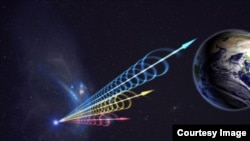Astronomers are closer to discovering the origin of something that has baffled them for the past decade.
Writing in the journal Nature, researchers from the University of British Columbia say a Fast Radio Burst appears to originate from “a highly magnetized, gas-filled region of space.”
FRBs, "bursts of energy from space that appear as a short flashes of radio waves to telescopes on Earth," last less than a second.
"We now know that the energy from this particular burst passed through a dense magnetized field shortly after it formed," said Kiyoshi Masui, an astronomer with the University of British Columbia in Canada and lead author of the new findings.
There are only 16 cases of recorded FRBs, but researchers say there could be thousands a day.
This particular one has been named FRB 110523 and is believed to have originated no more than 6 billion light-years away from Earth, placing it well outside our galaxy.
After sifting through massive amounts of data collected through radio astronomy, researchers say FRB 110523’s burst showed a Faraday rotation, “a corkscrew-like twist radio waves acquire by passing through a powerful magnetic field.”
The data also revealed that the burst had passed through to different areas of ionized gas called screens.
One of the screens appears to have been close, within a thousand light-years, to the source of the FRB, researchers said.
"This significantly narrows down the source's environment and type of event that triggered the burst--and means the source of the pulse likely resides within a star-forming nebula or the remnant of a supernova," said Masui.
Here's a video about the discovery:









